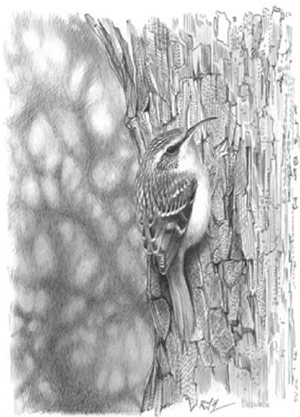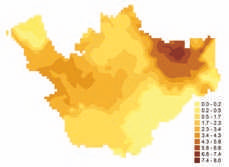
Treecreeper © Ren Hathway
The substantial reduction in breeding Treecreepers was one of the surprises of this Atlas. From the total in our First Atlas of 475 occupied tetrads, this survey showed a drop of 68, with a much larger decline in those with confirmed or probable breeding, falling by 110 from 357 to 247. The ‘change’ map shows widespread gaps across rural Cheshire, with noticeable losses from several tetrads around Chester and Macclesfield (although they are always scarce in urban areas) and it seems that they have retreated to the core woodland areas, as also suggested by the abundance map. From the submitted habitat codes, 85% of tetrads with Treecreeper records contained woodland, almost all of them broadleaved or mixed, with 15 records of birds in carr (waterlogged) woods. This might overstate the importance of woodland: trees are essential, but they often use hedgerows with mature oaks.
There seems to be little in the national statistics to explain a drop in occupation of Cheshire and Wirral tetrads. The BTO’s population index has fluctuated somewhat, but the UK figure was at the same level in 2004 as in 1980. The BTO’s analysis of Breeding Bird Survey transects shows that the breeding population of the county in 2004-05 was 6,270 birds (2,700-9,850). This figure amounts to 2.0% of the UK breeding population of about 319,000 Treecreepers (Newson et al 2008).
This seems to have been one of the more difficult species for many fieldworkers to prove breeding, with 45% of tetrads yielding two-letter codes. In 62 tetrads, recently-fledged juveniles were found, often well-camouflaged birds packed side-by-side in a frozen attitude, vertical on a tree-trunk as they await the return of their parents. In 71 tetrads, birds were seen carrying food: often a bird carrying food could be watched climbing a tree-trunk, then apparently disappear as it slipped behind a broken piece of bark into the nest, and 49 nests were found. Oak and alder were the only species of tree reported, with several birds using nest-boxes, and Treecreepers successfully nested in bird hides at Hattons Hey (SJ57T), as they have done before, and for four years in succession (2002-05) at Doddington Pool (SJ74D). Previously, nests have been reported in bat-boxes, in beech and sweet chestnut trees and in a crack in an outbuilding wall at Inner Marsh Farm (CWBRs).

Treecreeper abundance.
Treecreepers are well known for their feeding habits, starting at the bottom of a tree and working upwards in a spiral, picking insects from crevices in the bark. They especially eat spiders, but will take any insects that they find, and occasionally take wing to catch a small moth or other morsel flying past.
Sponsored by Tony Coatsworth and Gina Jones

